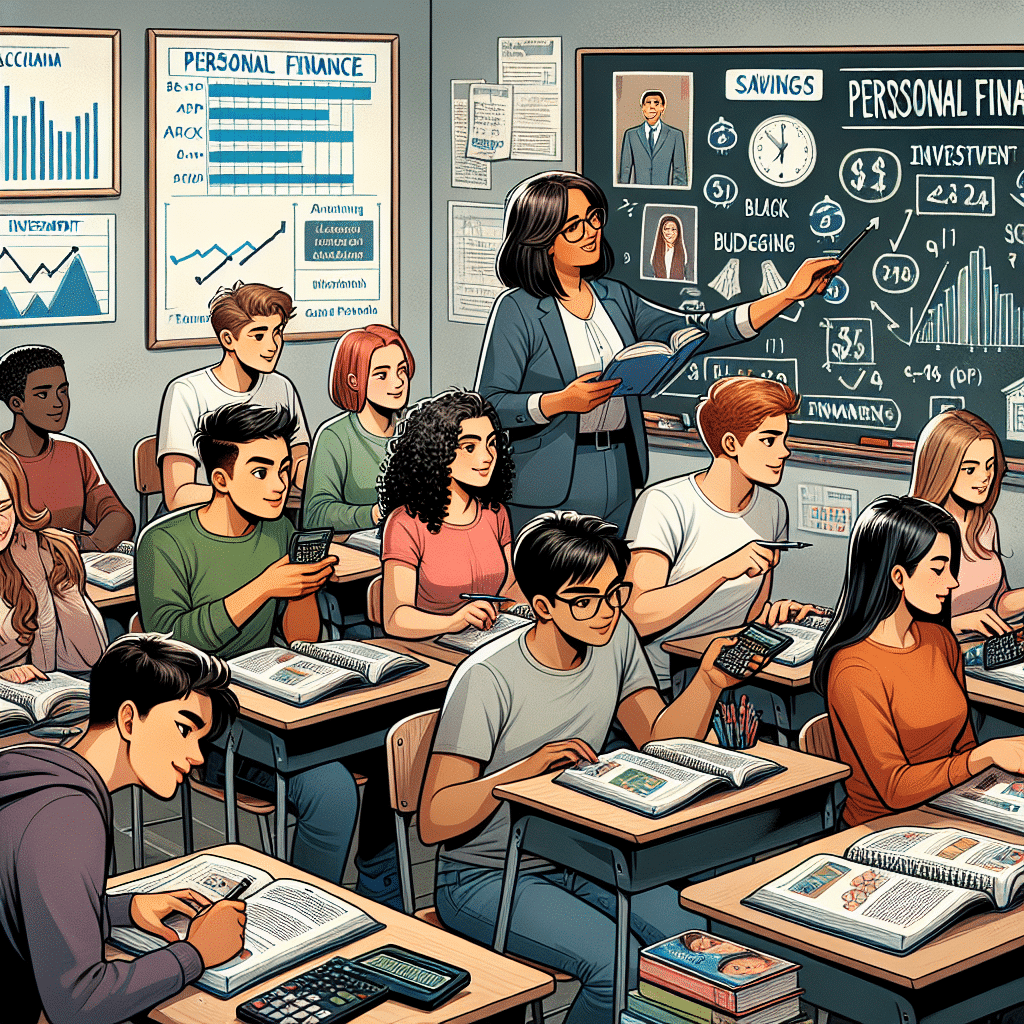
Personal finance education is crucial for individuals to understand how to manage their money effectively and make informed financial decisions. Whether at a young age or as adults, having a strong foundation in personal finance can greatly impact one’s financial well-being.
The Importance of Personal Finance Education
Personal finance education equips individuals with the knowledge and skills necessary to navigate the complex world of money management. It provides them with a toolkit to make informed decisions about saving, budgeting, investing, and planning for the future.
Without personal finance education, individuals may fall prey to common financial pitfalls, such as excessive debt, poor credit management, or inadequate retirement planning. These mistakes can have long-lasting consequences on their financial stability and overall well-being.
By teaching personal finance in schools, educators can empower students to become financially responsible adults. They can provide them with the building blocks to understand concepts like interest rates, taxes, and insurance, enabling them to make informed choices throughout their lives.
The Benefits of Including Personal Finance in School Curriculum
Including personal finance in the school curriculum offers numerous benefits for both students and society as a whole.
Firstly, it helps students develop essential life skills. Personal finance education teaches them how to create a budget, manage debt, save for emergencies, and invest for their future. These skills are vital for their financial success and independence as adults.
Secondly, incorporating personal finance in education can lead to improved financial literacy rates. Many individuals lack a basic understanding of financial concepts and struggle to make sound financial decisions. By educating students early on, we can create a more financially knowledgeable population.
Furthermore, personal finance education can help address economic inequality. Students from low-income backgrounds often have limited exposure to financial concepts and may face more significant barriers in managing their finances. By providing them with personal finance education, we can bridge this knowledge gap and empower them to overcome financial challenges.
Strategies for Incorporating Personal Finance in Education
There are various strategies that schools and educators can adopt to incorporate personal finance into the curriculum.
Firstly, schools can develop dedicated personal finance courses or modules. This allows students to delve deep into financial concepts and gain a comprehensive understanding of personal finance principles.
Secondly, personal finance topics can be integrated into existing subjects such as mathematics, economics, or social studies. This interdisciplinary approach enables students to see the practical application of financial concepts in real-life situations.
Additionally, schools can invite guest speakers, such as financial advisors or bankers, to share their expertise and provide practical insights. This exposes students to real-world experiences and perspectives, enhancing their understanding of personal finance.
Potential Challenges in Implementing Personal Finance Education
While personal finance education is essential, there are potential challenges in its implementation.
One challenge is the lack of qualified educators knowledgeable in personal finance. Schools may need to invest in professional development opportunities for teachers to ensure they can effectively deliver personal finance lessons.
Another challenge is the limited time and resources available within the school curriculum. Schools must strike a balance between personal finance education and other essential subjects, ensuring that each receives adequate attention.
Furthermore, there may be resistance from certain stakeholders who argue that personal finance education should be the responsibility of families rather than schools. Addressing these concerns and highlighting the importance of personal finance education is crucial for its successful implementation.
Resources and Tools for Personal Finance Education
There are numerous resources and tools available to support personal finance education in schools. Websites, textbooks, and educational software can provide interactive learning experiences and practical exercises. Financial literacy organizations and government agencies also offer free resources and educational programs that can be utilized in the classroom.
Furthermore, schools can establish partnerships with local financial institutions or community organizations that offer financial literacy programs. This collaboration can provide access to guest speakers, workshops, and other valuable resources.
In conclusion, personal finance education is vital for individuals to develop the necessary skills and knowledge to manage their money effectively. By incorporating personal finance into the school curriculum, we can empower students to make informed financial decisions and prepare them for a financially secure future.
The Benefits of Including Personal Finance in School Curriculum
Personal finance is a crucial topic that should be included in the school curriculum for several reasons. By providing students with the necessary knowledge and skills to manage their finances effectively, educational institutions can help prepare them for a financially secure future.
One of the primary benefits of including personal finance in schools is that it equips students with essential life skills. Many young adults enter adulthood without a basic understanding of financial concepts such as budgeting, saving, and investing. By teaching students about personal finance, schools empower them to make informed decisions about their money. They learn how to create and stick to a budget, manage debt, and save for their goals.
Furthermore, personal finance education in schools can contribute to poverty reduction and economic growth. With a solid foundation in financial literacy, individuals are less likely to fall into cycles of debt and are better equipped to plan for the future. This, in turn, can lead to increased economic stability and improved financial well-being for individuals, families, and communities as a whole.
Another benefit of incorporating personal finance in education is its potential to promote responsible and ethical financial behavior. By teaching students about the importance of saving, investing, and making sound financial decisions, schools can foster responsible financial behavior that can positively impact individuals and society in the long run. This knowledge can also help students avoid falling into fraudulent schemes or making poor financial decisions out of ignorance.
Including personal finance in the school curriculum can also bridge the gender wealth gap. Women tend to have lower financial literacy levels compared to men, which can contribute to gender inequality in financial matters. By providing equal access to personal finance education, schools can help address this gap and empower women to take control of their finances.
Lastly, personal finance education can have a positive impact on mental health and overall well-being. Financial stress is a leading cause of anxiety and depression. By teaching students how to manage their money effectively, schools can equip them with skills to navigate financial challenges and reduce stress.
In conclusion, including personal finance in the school curriculum offers numerous potential benefits for students. It provides them with essential life skills, contributes to poverty reduction and economic growth, promotes responsible financial behavior, bridges the gender wealth gap, and improves mental well-being. By prioritizing personal finance education, educational institutions can empower students to achieve financial security and success in their future endeavors.
III. Strategies for Incorporating Personal Finance in Education
Personal finance is a crucial life skill that all individuals should learn, and it is essential to incorporate it into the education system. By providing students with the knowledge and tools needed to make informed financial decisions, we can empower them to navigate the complexities of personal finance confidently.
Integrate Personal Finance into Existing Curriculum
One effective strategy for incorporating personal finance education is to integrate it into existing subjects like math and social studies. By using real-life examples and practical applications, educators can teach students about budgeting, saving, investing, and managing debt within the context of these subjects. This approach allows students to see the direct relevance and utility of personal finance in their daily lives.
Introduce Personal Finance as a Standalone Course
Another approach is to offer personal finance as a standalone course. This allows for a more comprehensive and in-depth exploration of personal finance topics. By dedicating an entire course to personal finance, educators can cover a wide range of essential topics, including budgeting, banking, credit, insurance, taxes, and investing. This focused approach allows students to gain a thorough understanding of these concepts and develop the skills needed for financial success.
Utilize Technology and Interactive Tools
Incorporating technology and interactive tools can make personal finance education more engaging and accessible to students. Online platforms, mobile apps, and interactive simulations can provide students with hands-on experiences in managing personal finances. These tools can help students track their spending, create budgets, simulate investment scenarios, and explore real-life financial challenges. By using technology, educators can leverage the familiarity and comfort that students have with digital platforms to enhance their learning experience.
Encourage Practical Application and Experiential Learning
Personal finance education should not be limited to theoretical knowledge alone. Encouraging students to apply what they have learned in real-life situations can help solidify their understanding and develop their skills further. Educators can facilitate experiential learning opportunities, such as organizing financial simulation events, inviting guest speakers from financial institutions, or creating partnerships with local businesses to offer internships or apprenticeships. These practical experiences allow students to apply personal finance concepts in a real-world context, fostering a deeper understanding and preparing them for future financial challenges.
In conclusion, incorporating personal finance education into the curriculum is crucial to equip students with the knowledge and skills they need to make informed financial decisions throughout their lives. By integrating personal finance into existing subjects, offering standalone courses, utilizing technology, and encouraging practical application, educators can ensure that students receive a comprehensive and relevant personal finance education.

The Challenges of Implementing Personal Finance Education
While the benefits of incorporating personal finance education into the school curriculum are clear, there are several potential challenges that may arise during implementation. These challenges can vary based on a variety of factors, including the age of students, the resources available, and the existing curriculum constraints. However, with careful planning and effective strategies, these challenges can be overcome to ensure the successful integration of personal finance education.
Lack of Teacher Training and Knowledge
One significant challenge in implementing personal finance education is the lack of training and knowledge among teachers. Many educators may not have received formal training in personal finance or may not possess the necessary expertise in the subject matter. This can make it difficult for them to effectively teach personal finance concepts to students.
To address this challenge, schools can provide training programs and resources for teachers to enhance their understanding of personal finance. This may include workshops, online courses, or partnerships with financial institutions or organizations specializing in personal finance education. By equipping teachers with the necessary knowledge and skills, they can confidently deliver personal finance education to their students.
Limited Time and Resources
Another challenge is the limited time and resources available for incorporating personal finance education into the curriculum. Schools already have a wide range of subjects and topics to cover, and finding additional time for personal finance education can be challenging. Additionally, schools may lack the necessary resources, such as textbooks, materials, or technology, to effectively teach personal finance.
To overcome these challenges, schools can consider integrating personal finance education into existing subjects or lessons. For example, personal finance concepts can be incorporated into mathematics, social studies, or economics classes. This allows schools to maximize the use of existing resources and time without adding an entirely new subject.
Age-Appropriate Curriculum
Developing age-appropriate curriculum for personal finance education is another essential consideration. Personal finance concepts can be complex, and younger students may struggle to grasp certain concepts that are more suitable for older students. It is crucial to adapt the curriculum to align with the cognitive abilities and comprehension levels of the students.
One approach is to introduce basic financial concepts in the early years and gradually build upon them as students progress through different grade levels. This ensures that students receive a solid foundation in personal finance and can gradually develop their financial literacy skills as they advance in their education.
In conclusion, while implementing personal finance education may pose certain challenges, it is crucial to overcome them to empower students with essential financial knowledge and skills. By providing teachers with training, optimizing existing resources, and developing age-appropriate curriculum, schools can successfully incorporate personal finance education into their educational programs.
Resources and Tools for Personal Finance Education
Personal finance education plays a crucial role in shaping the financial habits and skills of individuals, and it is essential to equip students with the necessary knowledge and resources to navigate their financial lives successfully. Educators and parents can utilize a variety of resources and tools to facilitate effective personal finance education.
1. Online Courses and Modules
There are numerous online platforms that offer personal finance courses and modules designed specifically for students at different levels. These courses cover a wide range of topics, including budgeting, saving, investing, debt management, and financial goal setting. Such resources provide interactive learning experiences, allowing students to grasp financial concepts effectively.
2. Mobile Applications
With the widespread use of smartphones, there are now many mobile applications available that can assist students in managing their personal finances. These apps offer features such as budget tracking, expense categorization, goal setting, and even investment management tools. By using these apps, students can gain hands-on experience in managing their finances on the go, promoting financial responsibility and accountability.
3. Financial Simulations and Games
Financial simulations and games are valuable tools for engaging students in hands-on learning experiences. These interactive resources allow students to simulate real-life financial situations, such as budgeting, investing, and making financial decisions. By participating in these simulations and games, students can develop critical thinking skills and gain practical knowledge of personal finance in a fun and immersive way.
4. Guest Speakers and Workshops
Inviting guest speakers, such as financial experts, professionals, and mentors, can provide students with real-world insights and experiences. These individuals can share their expertise and personal stories, offering practical advice and guidance on personal finance matters. Additionally, organizing workshops and seminars on personal finance topics can provide students with an interactive learning opportunity, allowing them to ask questions and engage in discussions.
5. Financial Literacy Organizations
There are several non-profit organizations dedicated to promoting financial literacy among young individuals. These organizations offer a wide range of educational resources, including lesson plans, worksheets, interactive games, and online tools. They often collaborate with schools or provide online resources that educators can utilize to enhance personal finance education in the classroom.
By utilizing these resources and tools, educators and parents can effectively incorporate personal finance education into the curriculum. This not only equips students with the necessary financial skills but also instills in them a sense of responsibility and confidence in managing their personal finances. As a result, they can make informed financial decisions, plan for the future, and achieve financial well-being as adults.
Incorporating personal finance education into the curriculum is a crucial step towards empowering students to become financially literate and responsible individuals in today’s complex financial landscape.

Summary
Personal finance education in schools plays a crucial role in equipping students with the knowledge and skills they need to effectively manage their finances and make informed financial decisions in the future. Including personal finance in the school curriculum offers numerous benefits, such as helping students develop lifelong money management skills, preparing them for financial independence, and increasing their financial literacy.
There are various strategies that can be employed to incorporate personal finance into education, including integrating financial topics into existing subjects, providing standalone personal finance courses, and utilizing interactive learning methods. By adopting these strategies, educators can ensure that students receive comprehensive and practical personal finance education.
However, implementing personal finance education may face several challenges, such as a lack of qualified teachers and limited resources. Overcoming these obstacles requires strong commitment from educational institutions, collaboration with financial institutions, and leveraging technology to enhance teaching and learning experiences.
To support personal finance education, a wide range of resources and tools are available, including financial literacy websites, online courses, apps, and interactive tools. These resources help students access relevant information, engage in hands-on activities, and develop practical financial skills, fostering their financial well-being and long-term success.






